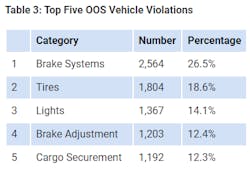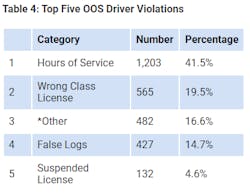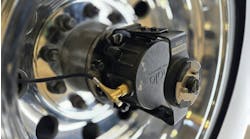Commercial motor vehicle inspectors removed more than 6,700 vehicles and 2,000 drivers from service during the Commercial Vehicle Safety Alliance's (CVSA) 2021 International Roadcheck. Overall, some 40,000 commercial vehicles were inspected during the three-day blitz, held May 4-6.
Each year, CVSA highlights a category of violations during International Roadcheck to bring awareness to certain aspects of a routine roadside inspection. This year, inspectors captured data on two categories: hours of service (HOS) and lighting.
According to the results, 1,367 out-of-service lighting violations accounted for 14.1% of all vehicle out-of-service violations. It was the third most-cited violation, after brake systems and tires. Out-of-service lighting device violations include headlamps, tail lamps, stop lamps, turn signals, and lamps on projecting loads.
Fred Fakkema, vice president of safety and compliance at Zonar Systems—and a former state patrol officer for over 25 years as well as a graduate of the FBI National Academy—shared his thoughts on the Roadcheck results and what drivers can do now to prepare for the upcoming Brake Safety Week.
“With any luck, drivers will see the CVSA report and note that the top vehicle violations during 2021 International Roadcheck were brake systems, tires, and lighting,” Fakkema said. “These types of violations are usually due to the driver failing to do a proper pre- and post-trip inspection. Tires and lighting are easy violations to correct with that inspection.
“Brakes, in particular, take a bit more time and include checking the brake lines, chamber, clamps, pushrod, slack adjuster, shoes and drums,” Fakkema added. “Without going through a proper list that guides drivers through these steps, it is easy to overlook some or all of them. Or, unfortunately, tempting to skip the step altogether so that you can get on the road.”
CVSA held an unannounced Brake Safety Day on May 26 where commercial motor vehicle inspectors in Canada, Mexico and the U.S. conducted 10,091 inspections. CVSA revealed that 1,273 vehicles were placed out of service for brake-related critical vehicle inspection items. The Alliance is holding its annual Brake Safety Week on Aug. 22-28.
“I advise that drivers take that extra bit of time to ensure that their pre- and post-trip inspections are correctly done,” Fakkema suggested. “Ideally, the inspections take place electronically and can be verified. Proper inspections help ensure that our roads are safer and save the driver and the company they work for time and money in the long run. With electronically verified inspections, a digital record is created and ensures that the drivers go to each inspection zone on a truck to complete the inspection.”
Of the 9,691 out-of-service vehicle violations issued, the top five violations were for brake systems, tires, lights, brake adjustment, and cargo securement.
The second focus area, HOS, was the most cited driver violation, accounting for 41.5% of all driver out-of-service violations. That’s 1,203 violations.
“HOS was the focus of the Roadcheck, and I believe that law enforcement has gotten comfortable with the ELD mandate,” Fakkema explained. “There was an initial learning curve, but law enforcement has had time to learn what to look for, including getting used to eRODS.”
In addition to law enforcement better understanding the mandate, Fakkema suggests the industry may be seeing the repercussions of too many ELDs on the market that were only required to be self-certified.
“The lack of a third-party certification of these devices often means that they don't end up meeting the ELD mandate requirements, putting drivers and fleets in a pinch,” Fakkema said. “Fleet managers should insist that their ELDs providers have received third-party validation.”
Since the start of the COVID-19 pandemic, the Federal Motor Carrier Safety Administration has issued emergency declarations to allow drivers aiding in the pandemic safety efforts. Fakkema believes that many drivers may be misusing these emergency declarations.
“Drivers need to work closely with their fleet managers to understand if and when they fall under these exemptions,” Fakkema explained. “Another issue is lack of parking for the drivers, they spend time looking for a place to rest, which at times can cause them to go over their hours or having to move the vehicle which the movement may impact their HOS. Increasing truck parking capacity and enhancing safety at rest stops is a priority for ATA’s LEAB (American Trucking Associations Law Enforcement Advisory Board).”
Of the 2,898 out-of-service driver violations issued, the top five violations were for HOS, wrong class license, other, false logs, and suspended license.
According to CVSA, examples of “other” driver violations include operating without the required operating authority, expired or no medical certificate, operating a commercial motor vehicle while ill or fatigued, driving while prohibited in the Drug and Alcohol Clearinghouse, etc.
“False logs came in at 14.7% for violations,” Fakkema added. “The ELD mandate has been out long enough for fleets and drivers to understand how to operate their ELDs. Unfortunately, there may be some drivers trying to get around the system.”
This article originally appeared on FleetOwner.com.






